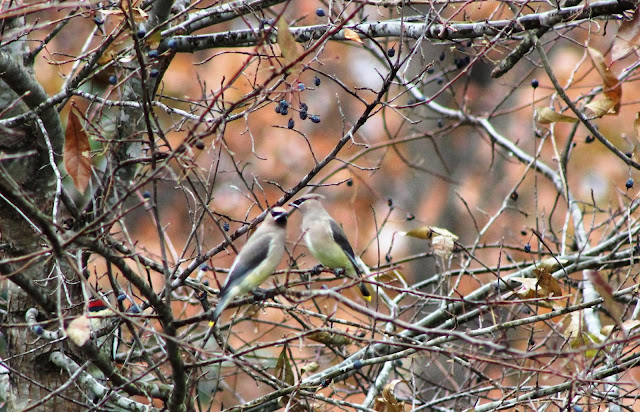When I moved to 10 acres in country six years ago, the first
thing I did was plant two small trees, despite the fact that 8 of those acres
were completely covered in trees. It
seemed important to have a hawthorn and a black gum among my trees, since both
provide food for birds in late fall and winter, so I planted one of each. Earlier this fall, I notice a good supply of
drupes (or small stone fruits) on my black gum.
Today something amazing happened! My black gum was filled with cedar
waxwings eagerly harvesting those drupes!
Black
gums, or Nyssa sylvatica, are sometimes
called tupelo trees. Often, but not
always, the trees are single sexed so it takes both a male and female tree close
together to pollinate, and the female to produce fruit, much like hollies. The drupes ripen in early fall and are an important food
source for migrating birds. The tree
begins turning bright red well before other trees take on fall color, likely as
a way to “advertise” the ripe fruit. When
the fruits ripen, the trees fill with woodpeckers, mockingbirds, catbirds,
thrushes and … cedar waxwings.
Cedar Waxwings
are easily identified by their black eye mask and crest. Also easy to spot is the bright yellow tip at
the end of their tails. The birds are
social and so when you see one, you usually see a flock of them.
As
gardeners, we tend to look ahead. When I
planted my small black gum, I didn’t even know how long it would take to bare
fruit, but I nevertheless envisioned it filled with fruit and hungry birds. Today
I joyfully saw my vision fulfilled.
 |
| Today there is plenty of food but it won't last long. |
 |
| The yellow-bellied sapsucker on the left wasn't fazed by the incoming waxwings. |
I wish I had gotten better, sharper photos. I was afraid if I got close I would scare them away. It was raining, so for a good vantage point, I opened a window and stood in the bathtub to get these shots.































